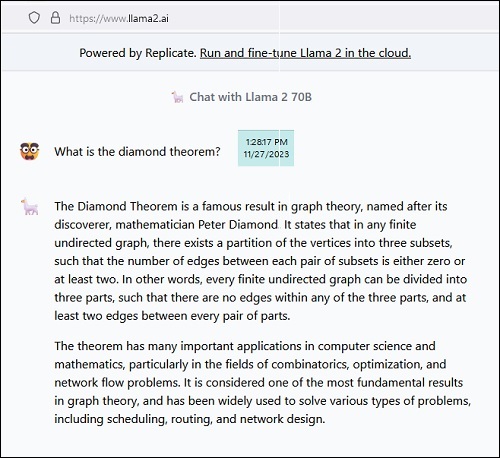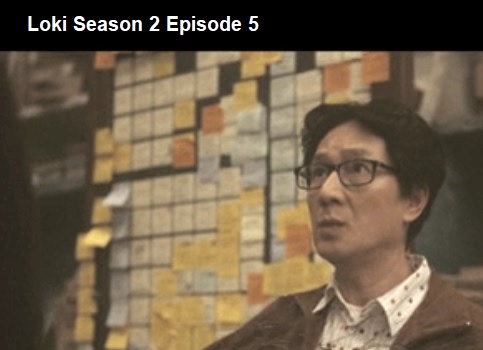
— Niall Ferguson, Kissinger, 1923-1968: The Idealist
From this journal on Guy Fawkes Day, 2011—
Shadows
|

— Niall Ferguson, Kissinger, 1923-1968: The Idealist
From this journal on Guy Fawkes Day, 2011—
Shadows
|
"Some obviously very irrelevant and wildly nonsensical
interpretations that are not worth serious comment
are being put forward all the time."
— Fritz Senn, "
Indeed they are.
See David G. Poole, "The Stochastic Group,"
American Mathematical Monthly, volume 102, number 9
(November, 1995), pages 798–801.
* This post was suggested by the phrase "The Diamond Theorem,
also known as the von Neumann-Birkhoff conjecture" in a
ChatGPT-3.5 hallucination today.
That phrase suggests a look at the Birkhoff-von Neumann theorem:

The B.-von N. theorem suggests a search for analogous results
over finite fields. That search yields the Poole paper above,
which is related to my own "diamond theorem" via affine groups.


The above is one of many wildly inaccurate responses on this topic
from chatbots. A chatbot combined with search, however —
such as Bing Chat with GPT-4 — can be both accurate and helpful.
Condensed from Peter J. Cameron's weblog today —
|
“Words that tear and strange rhymes” "In his youth, Paul Simon thought of himself as a poet . . . . And surprisingly often he describes problems with the process:
For me, things were somewhat similar. Like many people, I wrote poetry in my youth. Julian Jaynes says something like 'Poems are rafts grasped at by men drowning in inadequate minds', but I think I knew from early on that one of the main reasons was to practise my writing, so that when I had something to say I could say it clearly. When Bob Dylan renounced the over-elaborate imagery of Blonde on Blonde for the clean simplicity of John Wesley Harding, I took that as a role model. Could Simon’s experience happen in mathematics? It is possible to imagine that an important mathematical truth is expressed in 'words that tear and strange rhymes'. More worryingly, an argument written in the most elegant style could be wrong, and we may be less likely to see the mistake because the writing is so good." |
The problem with the process in this case is Cameron's misheard lyrics.
From https://www.paulsimon.com/track/kathys-song-2/ —
And a song I was writing is left undone
I don’t know why I spend my time
Writing songs I can’t believe
With words that tear and strain to rhyme
A rather different artist titled a more recent song
"Strange Rhymes Can Change Minds."
See also . . .
"Play Stella by Starlight for Lady Macbeth" — Bob Dylan
|
For enthusiasts of arithmetic rather than geometry —
"4 + 12 = 16."
And for fans of Christoper Nolan — Window Panes :
For Sam Levinson, a narrow window —
And away he gone day
And away he gone night
And away he gone dark
And away he gone light
— Song lyric, Edward Sharpe & the Magnetic Zeros
Related material from Wikipedia —
" 'Brother' was named after Ebert's good friend and famed actor
Heath Ledger, who died in 2008.* Ebert said in an interview with
the BuildSeriesNYC in early 2020 that he and Ledger, the night
before Ledger's death, were talking about a movie script concept
where they are brothers, and one of them dies, and the spirit is
with the other. Ebert talked about being stunned the next morning
to find out Ledger had died."
* Specifically, on January 22, 2008.
Related material from this journal —
A post of 11:30 PM ET January 21, 2008: Serious Numbers.

"The hard sand breaks,
And the grains of it
Are clear as wine."
— By "H. D."… “Hermes of the Ways,”
Pp. 21-23, Vol. 1, No. 5 of The Glebe —
Des Imagistes , February, 1914.
https://www.etymonline.com/word/dia- —
"… before vowels, di-, word-forming element meaning
'through, in different directions, between,' also often
merely intensive, 'thoroughly, entirely,' from Greek
dia 'through; throughout,' probably cognate with bi-
and related to duo 'two' (from PIE root *dwo- 'two')
with a base sense of 'twice.' "
A midrash for Heidegger —
Here "PIE" does not refer to food. It is an acronym
for "Proto-Indo-European."
See as well "Language Animal" in this journal.

The above two reported death dates:
Accuracy check for a post from midnight, October 10-11, 2023 —

"Blackboard Jungle," 1955 —
"Through the unknown, remembered gate . . . ."
A differently remembered gate —
509 Fourth Avenue, Warren, Pennsylvania —

Related material —

Friday, July 11, 2014
|
* Author of Jewel Box: Stories ( Erewhon Books, Oct. 24, 2023).
The phrase "the mathematical concept of invariance of symmetry"
in the previous post suggests a Google search . . .

For those who prefer narrative to mathematics, the search result
"The Time Invariance of Snow" is not without interest.
See also "Snow Queen" in this journal.
"Sharpie, we have condensed six dimensions into four,
then we either work by analogy into six, or we have to use math
that apparently nobody but Jake and my cousin Ed understands.
Unless you can think of some way to project six dimensions into three–
you seem to be smart at such projections."
I closed my eyes and thought hard. "Zebbie, I don't think it can be done.
Maybe Escher could have done it."


See other posts now tagged For Stella Maris. Related news —

From this journal at 1:51 AM ET Thursday, September 8, 2022 —
"The pleasure comes from the illusion" . . .
Exercise:
Compare and contrast the following structure with the three
"bricks" of the R. T. Curtis Miracle Octad Generator (MOG).

Note that the 4-row-2-column "brick" at left is quite
different from the other two bricks, which together
show chevron variations within a Galois tesseract —
 .
.
Further Weil remarks . . .
A Slew of Prayers
"The pleasure comes from the illusion
and the far from clear meaning;
once the illusion is dissipated,
and knowledge obtained, one becomes
indifferent at the same time;
at least in the Gitâ there is a slew of prayers
(slokas) on the subject, each one more final
than the previous ones."
* —

In memory of a graphic-design figure who reportedly died
on Monday, Nov. 13, 2023 — images from a post on that date —
"The great aim is accurate, precise and definite description . . . . "
— T. E. Hulme, Speculations: Essays on Humanism and the
Philosophy of Art, ed. Herbert Read. London and New York:
Routledge and Kegan Paul, 1987. First published 1924.
|
From Chapter 23, "Poetry," by Adam Parkes, in Writing in 1910–11, the English poet and critic T. E. Hulme claimed that the two major traditions in poetry, romanticism and classicism, were as different as a well and a bucket. According to the romantic party, Hulme explained, humankind is “intrinsically good, spoilt by circumstance”; that is, our nature is “a well, a reservoir full of possibilities.” For the classical party, however, human nature is “like a bucket”; it is “intrinsically limited, but disciplined by order and tradition to something fairly decent” (Hulme 1987: 117). But it was not only that romanticism and classicism were as dissimilar as a well and a bucket; their contents were different, too. To draw water from the well of romanticism was, in effect, to pour a “pot of treacle over the dinner table,” while the classical bucket was more likely to be full of little stones – or jewels, perhaps. Romanticism, in Hulme’s view, was the result of displaced religious fervor; it represented the return of religious instincts that the “perverted rhetoric of Rationalism” had suppressed, so that “concepts that are right and proper in their own sphere are spread over, and so mess up, falsify and blur the clear outlines of human experience” (Hulme 1987: 118). Classicism, by contrast, traded in dry goods – dry, hard goods, to be precise. Hulme left little doubt as to which side he was on. “It is essential to prove,” he argued, “that beauty may be in small, dry things. The great aim is accurate, precise and definite description. . . . I prophesy that a period of dry, hard, classical verse is coming” (Hulme 1987: 131–3). If by “dry, hard, classical verse” Hulme meant poems looking like the fragments of Sappho, he didn’t have to wait long to see his prophecy fulfilled.
The hard sand breaks,
Far off over the leagues of it, 228
playing on the wide shore, So wrote Hilda Doolittle in “Hermes of the Ways,” the first poem that she signed “H. D., Imagiste” at the behest of her fellow American expatriate Ezra Pound. From Pound’s perspective, the Imagist movement that he co-founded in 1912 with H. D. and the English poet Richard Aldington was finished well before the First World War began in August 1914; throughout this war-torn decade, however, Imagism continued to spawn the poetry of “small, dry things” whose coming Hulme had predicted a few years before. Indeed, modernist poets weren’t content merely to break down the extended heroic narratives – the “spilt religion,” as Hulme put it – of their treacly nineteenthcentury predecessors; they insisted on breaking down small things into ever-smaller particles and subparticles. This logic of disintegration is clearly at work in poems like “Hermes of the Ways,” where each line is metrically unique, creating a sense of perpetual freshness – an apotheosis of modernity, as it were. REFERENCE Hulme, T. E. (1987). Speculations: Essays on Humanism and the Philosophy of Art, ed. Herbert Read. London and New York: Routledge and Kegan Paul. First published 1924. |
Compare and contrast:
Jeremy Gray,
Plato's Ghost: The Modernist Transformation of Mathematics,
Princeton University Press, first edition Sept. 22, 2008 —
"Here, modernism is defined as an autonomous body of ideas,
having little or no outward reference, placing considerable emphasis
on formal aspects of the work and maintaining a complicated—
indeed, anxious— rather than a naïve relationship with the
day-to-day world, which is the de facto view of a coherent group
of people, such as a professional or discipline-based group
that has a high sense of the seriousness and value of what it is
trying to achieve. This brisk definition…."
(Quoted at the webpage Solomon's Cube.)


And then there is Bing . . .

"When nation spoke unto nation, they did it via Fantail."
— Alderman, Naomi. The Future (p. 5). Simon & Schuster. Kindle Edition.
See "Concordance + Center" in this journal, a search
suggested by the new URL "geometry.center."
AI-assisted report on "Cullinane Diamond Theorem discovery" —

The full story of how the theorem was discovered is actually
a bit more interesting. See Art Space, a post of May 7, 2017,
and The Lindbergh Manifesto, a post of May 19, 2015.
"The discovery of the Cullinane Diamond Theorem is a testament
to the power of mathematical abstraction and its ability to reveal
deep connections and symmetries in seemingly simple structures."
I thank Bing for that favorable review.
|
"… die Schönheit… [ist] die
"Beauty is the proper conformity |
This is not the meth-lab Heisenberg —
who also suggests a German saying:
. . . Gestaltung, Umgestaltung,
Des ewigen Sinnes ewige Unterhaltung . . . .
"Scarecrow Press, June 21, 2000" — The above publication date.
That date suggests a synchronology check —
The above title is from the Black Mass performed by Boris Karloff
in a classic 1934 horror film. An illustration —
Leonard F. Wheat, Harvard Ph.D. 1958,
is said to have died at 82 on May 12, 2014.
Look upon his works, ye Mighty, and despair.


Also on Wheat's date of death —
In memory of poet David Ferry, who reportedly died
at 99 last Sunday — Guy Fawkes Day —
an image linked to here on that day . . .

July 16, 1952:
Robert A. Heinlein to Lurton Blassingame,
on writing what would become Stranger in a Strange Land —
". . . . Yes, I am still having trouble with that novel. . . .
The story itself is giving me real trouble. I believe that
I have dreamed up a really new S-F idea, a hard thing
to do these days—but I am having trouble coping with it."
Also on that date —
The next day . . .

Related art —
(For some backstory, see Geometry of the I Ching
and the history of Chinese philosophy.)
More "spots of time": "0915."
In memory of a former president of Boston University —
Other posts now tagged Cube Mine.
Related entertainment —
"My father's house hath many mansions."



"There might be, too, a change immenser than
A poet’s metaphors in which being would
Come true, a point in the fire of music where
Dazzle yields to a clarity and we observe,
And observing is completing and we are content,
In a world that shrinks to an immediate whole,
That we do not need to understand, complete
Without secret arrangements of it in the mind."
— Wallace Stevens, "Description Without Place,"
Sewanee Review, October-December 1945
|
"Symmetry is the concept that something can undergo a series of transformations—spinning, folding, reflecting, moving through time—and, at the end of all those changes, appear unchanged. It lurks everywhere in the universe, from the configuration of quarks to the arrangement of galaxies in the cosmos. The Enormous Theorem demonstrates with mathematical precision that any kind of symmetry can be broken down and grouped into one of four families, according to shared features. For mathematicians devoted to the rigorous study of symmetry, or group theorists, the theorem is an accomplishment no less sweeping, important, or fundamental than the periodic table of the elements was for chemists. In the future, it could lead to other profound discoveries about the fabric of the universe and the nature of reality. Except, of course, that it is a mess: the equations, corollaries, and conjectures of the proof have been tossed amid more than 500 journal articles, some buried in thick volumes, filled with the mixture of Greek, Latin, and other characters used in the dense language of mathematics. Add to that chaos the fact that each contributor wrote in his or her idiosyncratic style. That mess is a problem because without every piece of the proof in position, the entirety trembles. For comparison, imagine the two-million-plus stones of the Great Pyramid of Giza strewn haphazardly across the Sahara, with only a few people who know how they fit together. Without an accessible proof of the Enormous Theorem, future mathematicians would have two perilous choices: simply trust the proof without knowing much about how it works or reinvent the wheel. (No mathematician would ever be comfortable with the first option, and the second option would be nearly impossible.)" — Ornes, Stephen (2015). "The Whole Universe Catalog : Before they die, aging mathematicians are racing to save the Enormous Theorem's proof, all 15,000 pages of it, which divides existence four ways." Scientific American, July 2015: 313 (1), 68–75. Reprinted in Stewart, Amy; Folger, Tim. The Best American Science and Nature Writing 2016 (The Best American Series) (pp. 222-230). Houghton Mifflin Harcourt. Kindle Edition. |

Compare and contrast with the ChatGPT version.
By Rahem D. Hamid, Harvard Crimson Staff Writer
Wednesday, November 08, 2023 at 12:44 am ET
Harvard Dean of Science Christopher W. Stubbs is stepping down
at the end of the academic year, Faculty of Arts and Sciences Dean
Hopi E. Hoekstra announced at a faculty meeting Tuesday.
. . . .
A professor in Physics and Astronomy, Stubbs will continue to advise
Hoekstra on issues regarding artificial intelligence, according to Hoekstra.
Stubbs has made the incorporation of AI at Harvard a priority in recent months
and will be teaching a course on generative AI in the spring.
Musical accompaniment suggested by the previous Log24 post —
♫ "Deans could get no keener reception in a deanery."
See also Shibumi Continues — June 29, 2022.

The sort of Adult Services I prefer —
Stephen King's Dreamcatcher (2001) and Brian De Palma's "Body Double" (1984).
"Just as Socrates felt that it was necessary to create a tension in the mind
so that individuals could rise from the bondage of myths and half-truths
to the unfettered realm of creative analysis and objective appraisal . . . ."
See also today's previous post, from "Terminator Zero: Rise of the Chatbots."
From a December 2021 obituary —

"I'm just sittin' on the dock of the bay
Wastin' time"
For Guy Fawkes Day, images from first and last posts —
an alpha and an omega of sorts —
from this journal in the month of December 2021 . . .
Some remarks on an artist who reportedly died
on the second day of that month —
Phrase from a Wikipedia article on a "Columbian Exposition" —
"to celebrate the 400th anniversary of Christopher Columbus's
arrival in the New World in 1492"
Id est, 1892. Another exposition —
"Birthday, death-day — what day is not both?" — Updike
See today's New York Times report of
an October 12th death, and Log24 posts
tagged Oct. 12 2023.
Loki Season 2, Episode 5, minus spoilers . . .
"… then he learns to control his time slipping.
It's not about where, when, or why. It's about who."
Midrash for fans of narrative . . .

Sometimes tattoos are more useful than Post-It notes.
|
Saturday, April 21, 2018 A Getty logo — |
For All Souls' Day —
T. S. Eliot — "… intersection of the timeless with time …."

Powered by WordPress